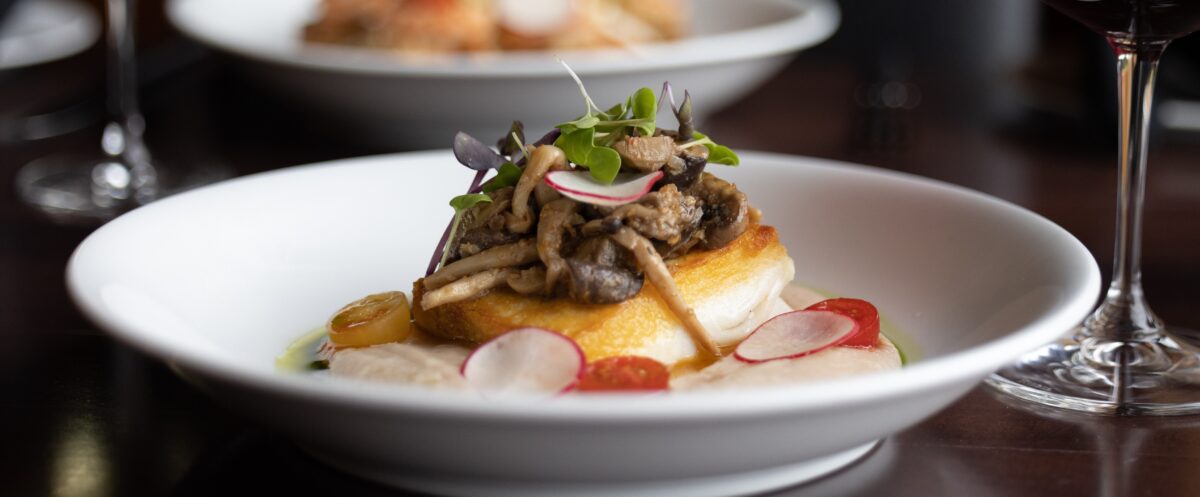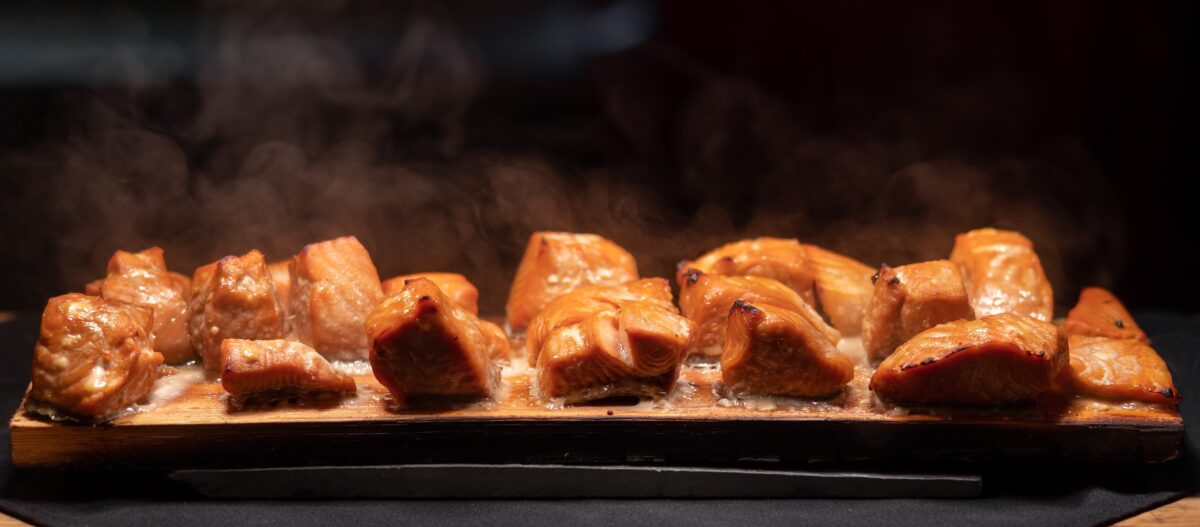Enjoying Your Catch!
But we know that knowing how to prepare your catch, after arriving home, can be overwhelming. To put your mind at ease, below are best practices to follow while preparing and cooking your catch. Knowing, and following, these key details will take your QCL catch from memorable to incredible.
Understanding Cookery
Depending on the species of fish, the color can vary from a deep, dark red to a paler orangey pink to an almost translucent white. The pigmentation of the flesh is dependent on the fish’s diet. Flesh should be firm to the touch and have a clean, ocean smell.
- Subcutaneous Fat
The time of year, availability of food, water temperatures and a number of other factors determine the thickness of the fat. It serves both as an energy storage and insulation for the fish during its migration from the ocean to the rivers.
- Skin
Some fish have thick, leathery skin which is similar in thickness and texture to chicken skin. It is ideal for cooking and rendering which results in a crispy texture to complement the delicate soft meat of the fish.
- At 110F and below
The flesh is essentially raw. Translucent and maintaining it’s original colouring, it has the soft, fleshy texture of good sashimi.
- At 110F – 120F
Your fish is rare or closer to medium rare. The connective tissue between layers of flesh has begun to weaken and if you insert a cake tester or toothpick into the fillet, it should slide in and out with no resistance. The meat is relatively opaque and moist.
- At 120F – 140F
The fish is closer to medium rare. Further cooking will increase flakiness and albumen will start to expel from the contracting muscle fibers and coagulate. At this stage, the fish will be overcooked if not removed from heat.
Ultimately, the goal is to keep the fish below the 140F temperature range, preferably as close to 120F as possible. The insulative subcutaneous fat acts as a heat barrier, transmitting heat to the interior flesh very, very slowly.
Cooking the Perfect Fish
While each fish is unique unto itself, and the thousands of ways to prepare those fish make each dish even more so, there are a few best practices that should be followed.
Tip #1 | The 10 Minute Rule
The most general rule to note is the ten-minute rule.
While beef is easy enough to tell when it’s cooked and the colour changes from red to brown, and it can be easy to spot the progression with tuna and swordfish, light coloured fish like salmon and halibut don’t share this quality. The best way to begin your preparations is to follow this method, which is to add 10 minutes of cooking time per inch of the filet’s thickness. No matter how you are looking to prepare your catch, whether its baking, grilling, steaming, or smoking, this number remains consistent.
Tip #2 | Preheat the Oil
A common problem when pan-frying any protein is that it can easily stick to the pan and tender fish will stick more so, causing it to tear when flipping. The key to preventing this is to make sure that the skin heats up as fast as possible. You’ll find subsequent flipping easier and a better end presentation when following this method.
Tip #3 | Dryer is Better
When placing your fish on a hot pan, the cold fillet, and any moisture from it will cool down the pan, also causing it to stick. Rather than working towards searing your meat, the energy from the hot oil ends up getting used to evaporate excess moisture. The dryer your meat before it goes in the pan, the better. To properly dry the fillets, press them firmly between paper towels. Seasoning with sea salt and fresh cracked pepper before transferring it skin-side down to the pan will help as well. The sea salt also has a secondary use, as it helps the skin to crisp up during cooking.
Tip #4 | Moisture
Knowing when to add moisture to will be the difference between a flaky, buttery bite of fish that melts in your mouth and a dry bite. Keeping your fish hydrated throughout the cooking process will also help retain the flavours you’re looking to impart into the fish.
For a lean fish (Halibut + Cod), baking it in a shallow pool of liquid or sauce, such as wine, butter, milk, water, or citrus juice, will create the desired texture. However, for an oily fish (Salmon), baking the fish on a rack atop a baking sheet to allow the juices to flow off will result in an evenly cooked, perfect moist piece. Differing from the lean fish, including flavours on the baking sheet will allow the flavour to be instilled through a simmering process.
Tip #5 | Keep the Fillet Flat
Salmon skin shrinks as it cooks and when heated on one side, the salmon fillet will begin to curl up on itself. This curvature can cause uneven cooking. To avoid this, use a flexible metal fish spatula to hold the fish firmly in place during the initial sear. After this the fillet should set in shape and will continue to cook evenly.
Tip #6 | Slow and Steady
In order to get a perfectly crisp, rendered skin, three things need to happen simultaneously: fat needs to render out, water needs to evaporate, and proteins need to set. Preheating the pan over a relatively high heat to prevent the sticking problems explained in Tip #1, then immediately reducing the heat once the salmon is added solves this problem. You end up with crisp, perfectly rendered, brown crunchy skin! Once the fish is ready for flipping, it will release with minimal sticking.
Tip #7 | Using Foil
An important question that comes with baking or grilling your fish, is should you use foil? There are two different ways in which you could do so, and choosing whether or not it will add to the process is key.
1. You can choose to completely encapsulate the fish in the foil, which will shorten cooking times and trap in the moisture which will essentially steam the fish creating a moist end result. As fish cooks quickly, consider shortening the cook time.
2. Lining the baking sheet with foil which will aid in cleaning up after the cooking is done. With the second option, if you form the foil like a pocket, it will keep the juices and marinades near the fish, again creating a delicious end result.
Tip #8 | Final Sear, Meat-side Down
Just before your fish reaches 110F, flip to give the flesh side a quick sear (removing at 120F). This will seal in the juices and retain moisture.
Chef Secrets
While the above tips are sure to prepare you for cooking the best fish, here are a few secrets from our Chefs that will not only help in your preparation, but also in your presentation.
Secret #1 | Removing Pin Bones
If your fish still have pin bones, use tweezers. Carefully pull out the pin bones in the same direction the bones are oriented.
Secret #2 | Searing the Skin
Properly seared fish skin is absolutely delicious and is considered a delicacy to many. To prepare, scrape off all of the scales, wash thoroughly, pat dry and season to your liking.
Secret #3 | Poaching and Flavour
Don’t poach your fish in plain water. Doing so would be a missed opportunity to add flavour! Herbs, citrus and spices are all great options. Traditional poaching liquid (or court bouillon) is flavoured with lemon, white wine, peppercorns, salt, herbs, and seasonings. Poaching salmon in flavoured olive oil is another fantastic way of cooking it while infusing flavour.
Secret #4 | Utilizing Wood Planks
It’s no secret that we’re big fans of a Cedar Plank Salmon but that’s not the only fish you can prepare with this style. A great foundation to create a rich, complex flavour no matter the species. Whether it’s with a peppery seasoning or citrusy marinade, putting the fish on the grill or smoker will bring depth to your plate.
Recipes
For more recipes, head on over to our blog page and check out the QCL Signatures Series. Every month we highlight a new recipe that is sure to impress!
I must comment on the fish processing. Each day’s catch is weighed and cleaned and cut to your specifications. We choose the portion pack which is a one pound serving size that is vacuum packed and flash frozen. They are then distributed in cartons at the South Terminal on the arrival back in Vancouver.
~Daniel T on TripAdvisor



 +1.800.688.8959
+1.800.688.8959